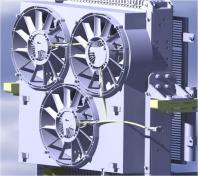The battery thermal mangement system is very important for keeping the battery healthy, making it work better, and making sure driving is safe. battery working at its best in a variety of situations by precisely controlling the temperature.
Is Thermal Management for Batteries? is it used for?
cars battery thermal management includes a number of methods and technologies used to keep the battery pack, electric motor, and power devices at right temperature. main job is to keep the battery within a certain temperature range so that it doesn't get too hot or too cold, which can hurt the battery's performance and usefulness.
It is reflected in the following aspects
- Safety and Performance: Proper thermal conditioning extends the life of the battery by stopping it from breaking down, speeds up charging by keeping the temperature at the right level, and makes sure that the battery always works at its best by keeping the power systems and motors from getting too hot.
- Longer Battery Life: Thermal management systems keep the vehicle at the right temperature, which extends the battery's useful life and improves total performance. This makes sure that the vehicle works reliably in all kinds of weather.
-Optimal Temperature Range- means that batteries work best within a certain temperature range. Too much heat can lead to thermal runaway, which is dangerous, and too little cool air can lower power output and shorten battery life.
What causes thermal runaway? How to stop it?
-What does Thermal Runaway mean?
Thermal runaway happens when the battery's temperature rises too quickly, which could cause a fire or explosion that can't be stopped. This happens when a battery cell has an internal short circuit. This starts a chain reaction where the heat that is made can't escape fast enough, making cells next to it get too hot.
Thermal Management System Strategies: Prevention and Mitigation
Overview of Battery Thermal Management Techniques
To prevent and mitigate thermal runaway in batteries, a variety of thermal management techniques can be employed. These techniques are critical to maintaining the safety and performance of the battery. The main methods include:
1. Liquid Cooling: uses a flowing coolant to get rid of heat quickly and keep all the battery cells at the same temperature.
2. Air Cooling: Moves air over the battery's sides with fans or natural convection to keep them from getting too hot.
3. Phase Change Materials (PCMs): To keep the battery's temperature stable, these are materials that take in and give off heat during phase changes.
4. Heat Pipes: move heat quickly through a covered tube that holds a working fluid, which is a good way to control the temperature.
Liquid cooling technology excels as one of the basic methods of controlling the heat generated during battery operation.
-Liquid Cooling Research
Thanks to the efficient heat transfer characteristics of the coolant, liquid cooling systems can effectively disperse the heat generated by the battery cells and keep the battery temperature within a safe threshold even under very high operating loads, ensuring stable system operation.
-Basic elements
The key medium for heat transfer is a liquid with high thermal conductivity, especially a water-glycol mixture.
Heat exchanger: This device is the basis for heat transfer and helps to transfer the heat generated by the battery to the cooling medium quickly, thus enabling efficient heat dissipation.
Driven by the cooling medium, a circulation pump ensures that the heat can be continuously and efficiently removed from the system.
Fluid and piping passages: Accurately delivering the cooling medium to each battery cell and directing the heat to the heat exchanger to form a closed-loop cycle relies on a carefully designed piping network.
GUCHEN liquid cooling system excels in battery thermal management, effectively preventing and mitigating thermal runaway problems through efficient heat transfer and uniform temperature distribution. It is suitable for a wide range of applications such as electric vehicles, construction machinery as equipment.
Comparative Analysis and Effective Situations
◆ Liquid cooling is more effective in dissipating high thermal loads, making it ideal for high-capacity batteries and rapid charging scenarios.
◆ Air cooling systems are simpler, with fewer components and lower maintenance costs, but they may not handle extreme thermal conditions as effectively as liquid cooling.
◆ Liquid cooling is preferred in high-performance EVs and applications requiring extensive thermal management, whereas air cooling may be adequate for smaller, less demanding setups or hybrid vehicles with less emphasis on battery performance.
Battery thermal management common problems:
◆ Why is battery thermal management important in electric vehicles?
It ensures the battery operates within the ideal temperature range, preventing damage, improving performance, extendin g battery life, enhancing safety, and optimizing charging efficiency.
◆ How often should the thermal management system be serviced?
Follow the manufacturer's recommendations, typically during regular maintenance checks. Liquid cooling systems may need more frequent inspections for coolant levels and leaks.
◆ How does climate affect the battery thermal management system?
Hot climates require the system to cool the battery more, while cold climates need it to warm the battery. Proper functioning is essential to handle extreme temperatures.









